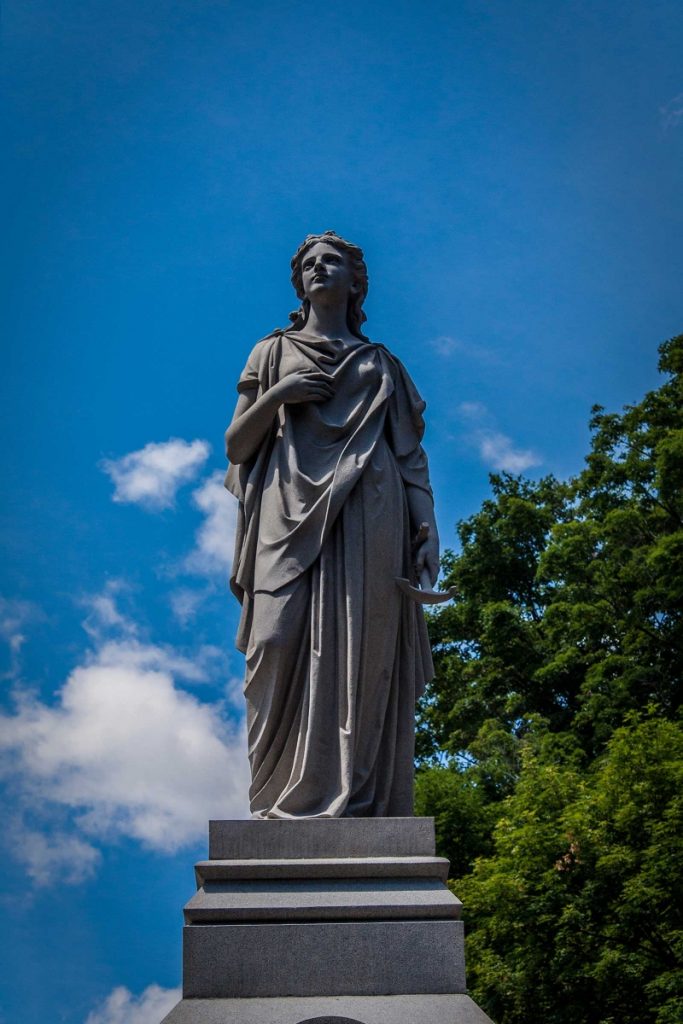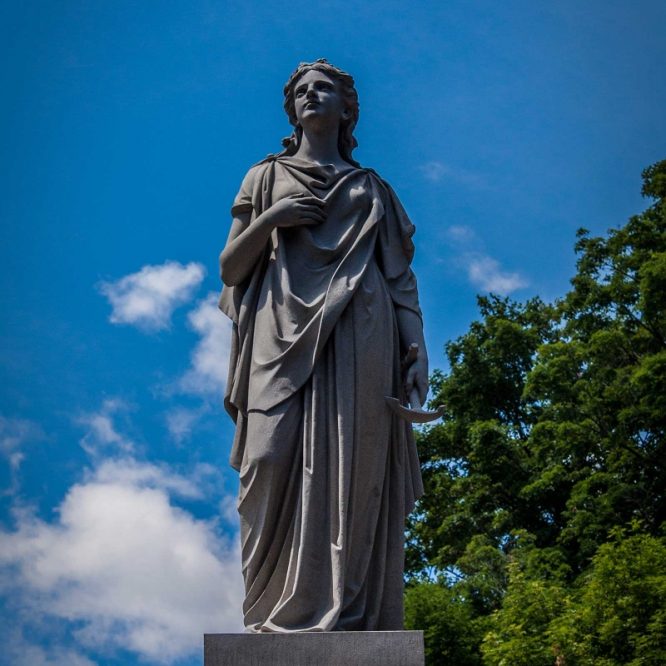Vol. 4, No. 34
August 26th will mark the final tour of Mt. Albion Cemetery this summer, which starts at 6:00pm and will travel a path across the western end of the cemetery. Over the last several weekends, I found myself intrigued by the visual representations of social and cultural changes throughout the cemetery. The earliest sections of the cemetery are characterized by a lack of uniformity, whether one looks at the varying size of lots, the random distribution of lot numbers, or the diverse styles of monuments. As one travels into the “newer” sections of the cemetery, lots are set out in uniform size, orientation, and cemetery monuments appear more similar to one another.
While preparing for these tours, I stumbled across excerpts from a Sears, Roebuck & Company catalog for marble cemetery monuments. An individual could purchase a headstone of modest size at a cost of $7.00-$8.00, plus additional rates for lettering and shipping. A later catalog distributed in 1906 provided prospective customers with samples of granite monuments, a relatively new business venture for the company.
One particular example from the catalog is reminiscent of some larger stones found within Mt. Albion. The “Art Renaissance” model is similar in style to that of the Alfred Skinner monument, although the ornamentation is far simpler with the catalog model. Customers could choose from several different sizes, running anywhere from $100.00 (or $2,768.00 with inflation) for a 4 foot 10-inch tall monument weighing 1,800 pounds to $312.30 (or $8,638.00 with inflation) for a 9 foot 2-inch tall monument weighing 11,680 pounds.
Production for a monument of this size required twelve weeks from quarry to cemetery, which included cutting the stone, lettering the face, and shipping by railroad. Typical lettering costs for granite ran anywhere from $.12 to $.72 per letter and customers could select typeface ranging in size from one inch to six inches in height. For raised lettering, prices ran anywhere from $.45 to $2.78 per letter ranging in size from one inch to 8 inches. Old English, German, Gothic, and ornamental lettering would cost customers nearly double the price of traditional fonts, so an individual could easily spend more than the cost of the stone itself when adding text depending upon the length of names, dates, and epitaphs.
Although standardized mail-order monuments were an option, many people preferred individualized monuments that displayed the artistic talents of local monument dealers. This particular memorial, standing upon lot 879 and paid for by Elizur Kirke Hart, is perhaps one of the most stunning and ostentatious monuments in the entire cemetery. Designed by Charles Diem of Albion in 1879, the large granite monument cost Mr. Hart roughly $7,900. Although the total amount spent on the memorial would run upwards of $236,000 today taking inflation into account, the artisanship and labor required to replicate such a beautiful piece of art would likely require double that amount at minimum. The monument stands upon an 8-square-foot base of granite with an eight-foot-tall statue of “Hope” resting on top.
The statue stands as a symbol of the virtue of hope; the desire and expectation of receiving something. In relation to cemetery symbolism, this often reflects hope for eternal happiness and divine union. Hope is one of seven Heavenly Virtues including Faith, Hope, Charity, Fortitude, Justice, Temperance, and Prudence; Faith, Hope, and Charity (or Love) are considered the three Theological Virtues. Held in her left hand is an anchor, a traditional Christian representation of hope as it often represented safety. In the Catholic tradition, the anchor is symbolic of the execution of St. Clement of Rome by Emperor Trajan, who was tied to an anchor and thrown into the sea.
In this depiction, Hope is dressed in a stola, the female counterpart to the Roman toga, with her right hand over her breast as a representation of faith. In other depictions, her index finger points to the sky as a representation of the path to heaven. A similar, smaller statue stands upon the gravesite of David Jones and James Whitney near the Soldiers & Sailors Monument. On that particular example, the large anchor rests at Hope’s feet with a chain attached.
Charles Diem was also responsible for a number of other strikingly beautiful monuments throughout the cemetery including the marble tablets found within the Soldiers & Sailors Monument, the large bald eagle draping a mourning cloth over the monument of Col. Robert H. Graham (just west of the tower), and the stunning marble baldacchino that stands on the Sanford E. Church lot. Of course, Sears, Roebuck & Company could not replicate the beauty and complexity of these monuments.


